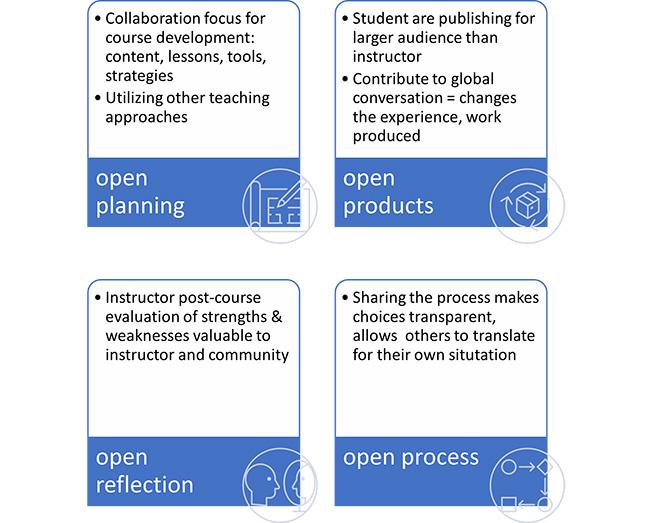Open pedagogy
Adapted from the UBC Program for Open Scholarship and Education (CC BY).
Open pedagogy is the application of the concepts of open to the practices of teaching and learning. It can involve a blend of strategies, technologies, and networked communities to empower students to have control and agency over their own learning.
Open pedagogy principles
The core values for open pedagogy, as Caroline Sinkinson states, include teaching and learning practices that reduce barriers that prevent equitable access to education, including economic, technical, social, cultural, and political factors.
Open pedagogy facilitates connections across the boundaries of learning experiences that occur within classrooms, on campuses, and in communities by critically engaging with tools and practices that mediate learning, knowledge building, and sharing.
Open pedagogy also protects the agency and ownership of one’s own learning experiences, choices of expression, and degrees of participation and resists the treatment of open as neutral by providing space for critical evaluation and reflection.
Open pedagogy is thus situated at the intersection of teaching and learning and social justice and often builds upon theories of critical pedagogy which sought to use the educational process to challenge existing knowledge and beliefs to achieve individual empowerment and social change.
Features of open pedagogy
Features of open pedagogy - infographic is a summary of Tom Woodward's highlights with the addition of open process (see Open Pedagogy: Connection, Community, and Transparency -- Campus Technology)
Activities of open pedagogy
- Using all and only open resources in one’s course, such as readings that are not only free to read, but also openly licensed to allow downloading, revision, annotating, etc.
- One’s entire course site is public and openly licensed even if one doesn’t post ALL aspects of a course publicly. Of course, things such as student marks should remain private, and one may also choose to not post exams so they can be reused later.
- Any student work or instructor teaching and learning resources that are posted to a public site are also given an open license.
- Openness extends to getting and incorporating feedback on the course and its open resources, whether instructor-produced or student-produced.
- Not only products are open (such as the course site, teaching and learning resources, student work), but also processes. For example, one shares the processes of designing a course, of how a video was created, of how well a particular open assignment worked, etc.
- One could open an entire course to participants from outside the institution (such as in a MOOC), still ensuring that the course elements are openly licensed
Students as equal contributors to learning
While open scholarship focuses on equitable access to knowledge, the focus of open pedagogy is equitable participation in the creation of knowledge. In this way, open pedagogy often transforms the student experience within the classroom. It can help students begin to see themselves as scholars and it de-centres the instructor from the information expert to a facilitation role that supports student negotiation of ideas and transforms the efforts of their learning into open knowledge resources. If a core goal of scholarship is research, dissemination, and dialogue to further the knowledge base and growth of fields of study, then open pedagogy engages students in this very same process within their courses. Students are asked to create new knowledge and given a degree of agency, autonomy, and control over their work.
Having students be creators of content, described as a “Student as Producer” model by Mike Neary at the University of Lincoln, emphasizes the student role as collaborators with instructors in the production of knowledge. By engaging students in knowledge production and sharing, the model helps transform students from being the object of the educational process to being the subject of it. Additionally, in the student as producer model, the university’s approach to learning and research are closer aligned; for example, students, similar to researchers, are asked to share their work with authentic audiences and not just with their immediate instructor or adviser. As Neary and Winn state, in this way students become part of the academic project of the University and collaborators with academics in the production of knowledge and meaning.
Evaluating OERs in pedagogical terms
Wiley and Hilton state that when student works are openly licensed, “granting others 5R permissions in their use of the artifacts, each work becomes the beginning of an ongoing conversation in which other learners participate as they contextualize and extend the work in support of their own learning. Open licensing also ensures that these artifacts will be perpetually and freely available to all who wish to engage them as part of their learning." Wiley and Hilton suggest the following questions can help to determine the extent to which a specific teaching and learning practice qualifies as OER-enabled pedagogy:
- Are students asked to create new artifacts (essays, poems, videos, songs, etc.) or revise/remix existing OER?
- Does the new artifact have value beyond supporting the learning of its author?
- Are students invited to publicly share their new artifacts or revised/remixed OER?
- Are students invited to openly license their new artifacts or revised/remixed OER?
Resources
- UBC Open Pedagogy
- Open Pedagogy Notebook
- OER Capability Toolkit

